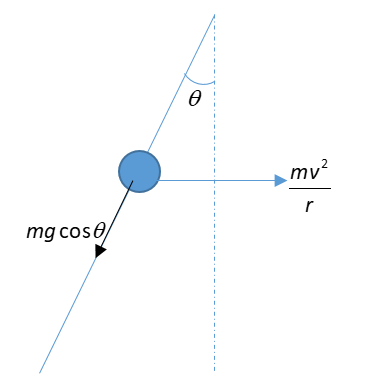
A cyclist on the ground goes round a circular path of circumference 34.3m in \[\sqrt {22} \] sec. The angle made by him with the vertical will be,
A. 45°
B. 40°
C. 42°
D. 48°
Answer
218.7k+ views
Hint:When a cyclist is moving around a circular path than the center of mass shifts towards the center of the circular path. To balance the moment of force the angle with the vertical be such that the component of the weight of the cyclist is balanced by the outward force along the inclined line.
Formula used:
\[{f_0} = \dfrac{{m{v^2}}}{r}\]
Here \[{f_0}\] is the radially outward force of mass m moving in a circular path of radius r with speed v.
Complete step by step solution:

Image: Free body diagram of cyclist
Let the angle made by the cyclist vertically is \[\theta \]. At equilibrium, the net force acting on the cyclist must be zero. We resolve the force along the inclined line. Let the inclined plane be the x-axis with an upward direction as positive and a downward direction as negative. The net force acting on the cyclist along the x-axis must be zero to attain equilibrium while making the circular path.
\[\sum {{F_x}} = 0\]
\[\Rightarrow \dfrac{{m{v^2}}}{r}\sin \theta - mg\cos \theta = 0\]
By simplifying, we get
\[\dfrac{{m{v^2}}}{r}\sin \theta - mg\cos \theta = 0\]
\[\Rightarrow \dfrac{{m{v^2}}}{r}\sin \theta = mg\cos \theta \]
\[\Rightarrow \tan \theta = \dfrac{{rg}}{{{v^2}}}\]
\[\Rightarrow {\tan ^{ - 1}}\left( {\dfrac{{rg}}{{{v^2}}}} \right)\]
If the radius of the path is r, then using the circumference formula,
\[2\pi r = C\]
\[\Rightarrow r = \dfrac{C}{{2\pi }}\]
The speed is the distance travelled per unit of time,
\[v = \dfrac{C}{t}\]
Putting the values, we get
\[\theta = {\tan ^{ - 1}}\left( {\dfrac{{\left( {\dfrac{C}{{2\pi }}} \right)g}}{{{{\left( {\dfrac{C}{t}} \right)}^2}}}} \right)\]
\[\Rightarrow \theta = {\tan ^{ - 1}}\left( {\dfrac{{g{t^2}}}{{2\pi C}}} \right)\]
\[\Rightarrow \theta = {\tan ^{ - 1}}\left( {\dfrac{{9.8 \times {{\left( {\sqrt {22} } \right)}^2}}}{{2\pi \times 34.3}}} \right)\]
\[\Rightarrow \theta = {\tan ^{ - 1}}\left( {1.00} \right)\]
\[\therefore \theta = 45^\circ \]
Therefore, the required angle made by the cyclist with the vertical is 45°.
Therefore, the correct option is A.
Note: When the road is frictional then the frictional force acts opposite to the direction of potential skidding of the tyre of the cycle. If the outward force on the cyclist is greater or less than the frictional force between the tyre and the road then the cyclist can lose balance. So to balance the forces cyclists make an angle vertically.
Formula used:
\[{f_0} = \dfrac{{m{v^2}}}{r}\]
Here \[{f_0}\] is the radially outward force of mass m moving in a circular path of radius r with speed v.
Complete step by step solution:

Image: Free body diagram of cyclist
Let the angle made by the cyclist vertically is \[\theta \]. At equilibrium, the net force acting on the cyclist must be zero. We resolve the force along the inclined line. Let the inclined plane be the x-axis with an upward direction as positive and a downward direction as negative. The net force acting on the cyclist along the x-axis must be zero to attain equilibrium while making the circular path.
\[\sum {{F_x}} = 0\]
\[\Rightarrow \dfrac{{m{v^2}}}{r}\sin \theta - mg\cos \theta = 0\]
By simplifying, we get
\[\dfrac{{m{v^2}}}{r}\sin \theta - mg\cos \theta = 0\]
\[\Rightarrow \dfrac{{m{v^2}}}{r}\sin \theta = mg\cos \theta \]
\[\Rightarrow \tan \theta = \dfrac{{rg}}{{{v^2}}}\]
\[\Rightarrow {\tan ^{ - 1}}\left( {\dfrac{{rg}}{{{v^2}}}} \right)\]
If the radius of the path is r, then using the circumference formula,
\[2\pi r = C\]
\[\Rightarrow r = \dfrac{C}{{2\pi }}\]
The speed is the distance travelled per unit of time,
\[v = \dfrac{C}{t}\]
Putting the values, we get
\[\theta = {\tan ^{ - 1}}\left( {\dfrac{{\left( {\dfrac{C}{{2\pi }}} \right)g}}{{{{\left( {\dfrac{C}{t}} \right)}^2}}}} \right)\]
\[\Rightarrow \theta = {\tan ^{ - 1}}\left( {\dfrac{{g{t^2}}}{{2\pi C}}} \right)\]
\[\Rightarrow \theta = {\tan ^{ - 1}}\left( {\dfrac{{9.8 \times {{\left( {\sqrt {22} } \right)}^2}}}{{2\pi \times 34.3}}} \right)\]
\[\Rightarrow \theta = {\tan ^{ - 1}}\left( {1.00} \right)\]
\[\therefore \theta = 45^\circ \]
Therefore, the required angle made by the cyclist with the vertical is 45°.
Therefore, the correct option is A.
Note: When the road is frictional then the frictional force acts opposite to the direction of potential skidding of the tyre of the cycle. If the outward force on the cyclist is greater or less than the frictional force between the tyre and the road then the cyclist can lose balance. So to balance the forces cyclists make an angle vertically.
Recently Updated Pages
Two discs which are rotating about their respective class 11 physics JEE_Main

A ladder rests against a frictionless vertical wall class 11 physics JEE_Main

Two simple pendulums of lengths 1 m and 16 m respectively class 11 physics JEE_Main

The slopes of isothermal and adiabatic curves are related class 11 physics JEE_Main

A trolly falling freely on an inclined plane as shown class 11 physics JEE_Main

The masses M1 and M2M2 M1 are released from rest Using class 11 physics JEE_Main

Trending doubts
JEE Main 2026: Application Form Open, Exam Dates, Syllabus, Eligibility & Question Papers

Derivation of Equation of Trajectory Explained for Students

Hybridisation in Chemistry – Concept, Types & Applications

Understanding the Angle of Deviation in a Prism

Understanding Collisions: Types and Examples for Students

Understanding Atomic Structure for Beginners

Other Pages
JEE Advanced Marks vs Ranks 2025: Understanding Category-wise Qualifying Marks and Previous Year Cut-offs

Units And Measurements Class 11 Physics Chapter 1 CBSE Notes - 2025-26

NCERT Solutions For Class 11 Physics Chapter 8 Mechanical Properties Of Solids

Motion in a Straight Line Class 11 Physics Chapter 2 CBSE Notes - 2025-26

NCERT Solutions for Class 11 Physics Chapter 7 Gravitation 2025-26

How to Convert a Galvanometer into an Ammeter or Voltmeter




